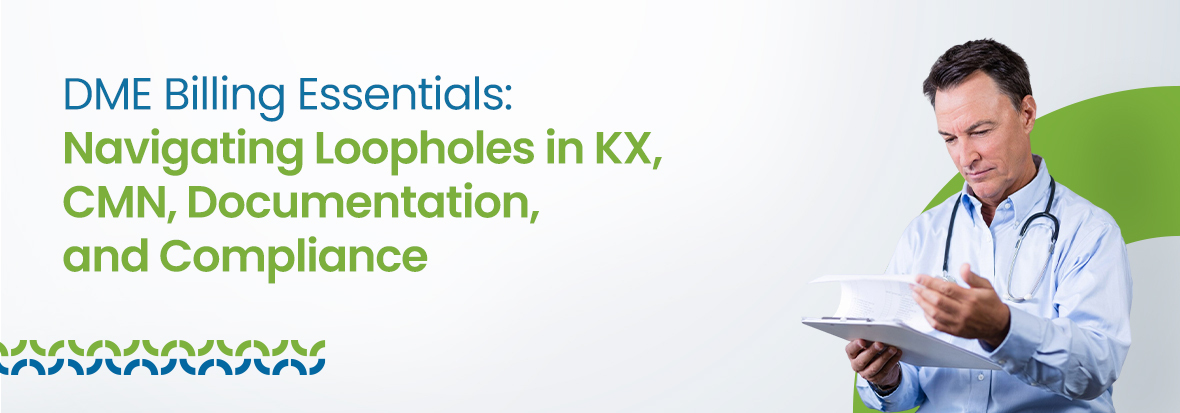For healthcare providers, Durable Medical Equipment billing can often feel like walking through a maze of complex rules, modifiers, and documentation requirements. Whether you’re ordering wheelchairs, oxygen therapy, knee braces, or other DME items, navigating the regulatory landscape can be overwhelming. The pressure to meet the strict guidelines of Medicare and private insurers, while ensuring timely reimbursement, can result in costly mistakes, delayed payments, and unnecessary denials.
The key to avoiding these pitfalls lies in understanding the intricacies of DME billing, particularly the essential components such as the KX modifier, Certificate of Medical Necessity (CMN), and accurate documentation. Many providers face challenges due to gaps in understanding these technicalities, leading to confusion and compliance issues. In fact, missteps in the documentation process, the misapplication of DME modifiers, or overlooking critical payer rules are some of the leading causes of claim denials.
In this blog, we’ll break down the critical billing requirements, identify the loopholes that can cause financial headaches, and give you actionable solutions to fix those issues before they affect your practice. By improving your DME billing process, mastering DME medical coding, and staying on top of these essential steps, you’ll not only streamline your operations but also ensure that you receive payment for the equipment your patients need on time, every time.
What is DME Billing?
DME billing involves submitting claims to Medicare or private insurance, ensuring the provider receives payment for the equipment. Correct billing helps patients obtain the necessary items and enables providers to receive payment. If a claim is incorrect, the item may not be reimbursed. That can cause stress for patients and money problems for the office.
Key Parts of DME Billing: KX Modifier, CMN, SWO, and Documentation
There are a few key things to know when billing for DME. These items and rules frequently appear in denials and audits. Learn them and teach your team.
KX Modifier
The KX modifier is a code to put on a claim to say, “All the rules for coverage are met.” KX is only used when the rules in the Local Coverage Determination (LCD) or policy are satisfied.
What the chart must show:
- The reason the item is medically necessary, as stated in the LCD.
- A face-to-face (F2F) visit note, if required by the LCD.
- Order details: patient name, item name or HCPCS code, provider signature, and date.
Loophole to Avoid: Don’t add KX if the medical record does not fully prove the need. Using KX without clear notes will result in denials.
Do you want to avoid KX-related denials?
Certificate of Medical Necessity (CMN)
Medicare used to require CMNs and DIFs to prove medical need for certain DME. Change: As of January 1, 2023, Medicare stopped using CMNs and DIFs for dates of service on or after that date.
Now, all documentation must be included in the patient’s regular medical record and must follow the LCD for the specific item. That means the chart needs clear notes that match the LCD rules.
Loophole to avoid: Don’t keep using old CMN forms. They may be rejected. Ensure the chart includes clear medical-need notes instead.
Standard Written Order (SWO)
A Standard Written Order is required for all DME claims. It must be ready before the supplier bills are due.
SWO must include:
- Patient name and Medicare Beneficiary Identifier (MBI).
- Date of the order.
- Item description (HCPCS code or clear narrative).
- Quantity, if needed.
- Prescriber’s name and NPI.
- Prescriber’s signature.
Loophole to avoid: Incomplete or generic SWOs cause denials. Always fill every required field and check the SWO before sending it to the supplier.
Common Loopholes and How to Fix Them
Missing or Incorrect Documentation
Missing notes or incorrect information are a primary reason for denials. If the chart does not show the need or the provider’s signature, payers often deny the claim.
Fix: Ensure that medical necessity, SWO, and proof of delivery (POD) are complete, and double-check charts before sending claims.
Not Meeting F2F and WOPD Rules
Some items need a Face-to-Face visit within six months before the order. Some items also require a Written Order Before Delivery (WOPD).
Fix: Confirm that the F2F visit occurred within the correct time frame and that the SWO was sent before delivery. Check each LCD as the rules can vary by item.
For example, oxygen equipment often requires a recent face-to-face visit and specific test results to ensure proper functioning. If those are not in the chart, the claim will be denied.
Forgetting Prior Authorization (PA)
Some items require a Prior Authorization. If PA is missing, the claim can be denied.
Fix: Always check if PA is required. Get PA before delivery and include all needed documents.
Using the Wrong Modifiers (KX vs GA/GZ)
KX = all coverage rules met.
GA = provider expects denial but has a signed ABN (Advance Beneficiary Notice).
GZ = provider believes the item is not covered or is unsure and does not have an ABN.
Loophole to avoid: Don’t mix KX with GA or GZ. Use the correct modifier for the situation and ensure ABNs are signed when necessary.
Automatic Refills and Early Shipments
Suppliers sometimes ship supplies too early or without patient confirmation.
Fix: Follow Medicare rules by confirming continued need within 30 days of the expected end date of current supplies. Do not deliver supplies earlier than 10 days before the current supply is due to run out.
Same or Similar Item Denials
Medicare may deny a new item if the patient already has the same or a similar item that is still within its Reasonable Useful Lifetime (RUL).
Fix: Check patient history before ordering. Don’t order a replacement if the existing item is still within its RUL, unless the rules allow it. Document why a new item is needed if it is an exception.
Best Practices for DME Billing Success
Invest in Documentation Systems
Use a good EHR or practice management system. Set alerts for F2F visits and prior authorizations. Keep SWOs, orders, and proof of delivery easily accessible.
Educate your Staff
Teach billing teams about KX, SWO, F2F, PA, and modifier rules. Make simple checklists for common DME items. Role-play common scenarios to allow staff to practice.
Stay Updated on Payer Rules
LCDs and payer guides change. Check them often. Update your checklists when rules change. Subscribe to payer emails or alerts.
Perform Regular Audits
Review a sample of charts and claims to identify errors before payers do. Resolve issues promptly to prevent repeated denials. Track trends to identify where most mistakes occur.
Sample Documentation Checklist
- Is the medical reason for the item in the chart, and does it match the LCD? Yes / No
- Is there a face-to-face visit note if required? Yes / No
- Is the SWO complete with MBI, date, HCPCS, NPI, and signature? Yes / No
- Is proof of delivery (POD) on file? Yes / No
- Is a prior authorization required and on file? Yes / No
- Is the correct modifier used (KX, GA, GZ)? Yes / No
- Does the patient already have a similar item in the RUL period? Yes / No
Common DME Items and Notes to Watch
Oxygen and oxygen supplies
- Often need tests, F2F notes, and careful documentation. Confirm results and dates in the chart.
Power wheelchairs and scooters
- Verify the RUL, ensure proper measurements, and document clear notes explaining why the mobility device is necessary.
Orthotics and prosthetics
- Document measurements, fittings, and follow-up care as needed. Have clear notes about the function and the medical need.
Walkers, canes, and simple aids
- Even simple items need the right notes. Sometimes, payers deny items if the chart does not clearly indicate why crutches or a cane are necessary.
Tips to Avoid Audits and Denials
- Be consistent: Use the same language and templates for orders and notes.
- Date everything: Missing dates cause many denials.
- Sign and date: Provider signatures must be clear and dated.
- Keep copies: Keep a copy of the SWO and proof of delivery with the claim.
- Use measurable details: Write how far the patient can walk, what tasks they cannot do, and why the device will help.
- Communicate with suppliers: Make sure suppliers have the SWO before delivery.
Ready to improve your DME billing process?
What to do When a Claim is Denied
- Read the denial notice carefully to see the reason.
- Gather the chart, SWO, POD, and any test results.
- If a PA is needed but missing, get the PA and resubmit if allowed.
- Request a medical review if necessary and provide clear documentation to support your request.
- Appeal if you have a strong case and the documentation supports your claim for coverage.
Why CMNs Were Retired and What Changed
Medicare retired CMNs and DIFs on January 1, 2023, to simplify forms. However, this change requires that all proof of need be documented in the patient’s chart and adhere to LCDs. The forms are gone, but the need for good notes is bigger.
Conclusion
DME billing needs careful paperwork and a clear process. Common mistakes include using incorrect modifiers, failing to document, and not following F2F or PA rules. Please note that CMNs were retired as of January 1, 2023, so the chart must now contain all proof of medical need. Use complete SWOs, avoid adding KX without evidence, and follow refill rules. Train staff, utilize effective systems, and conduct regular audits to ensure optimal performance and efficiency. Following these steps helps ensure claims are paid and enables patients to obtain the necessary equipment.

